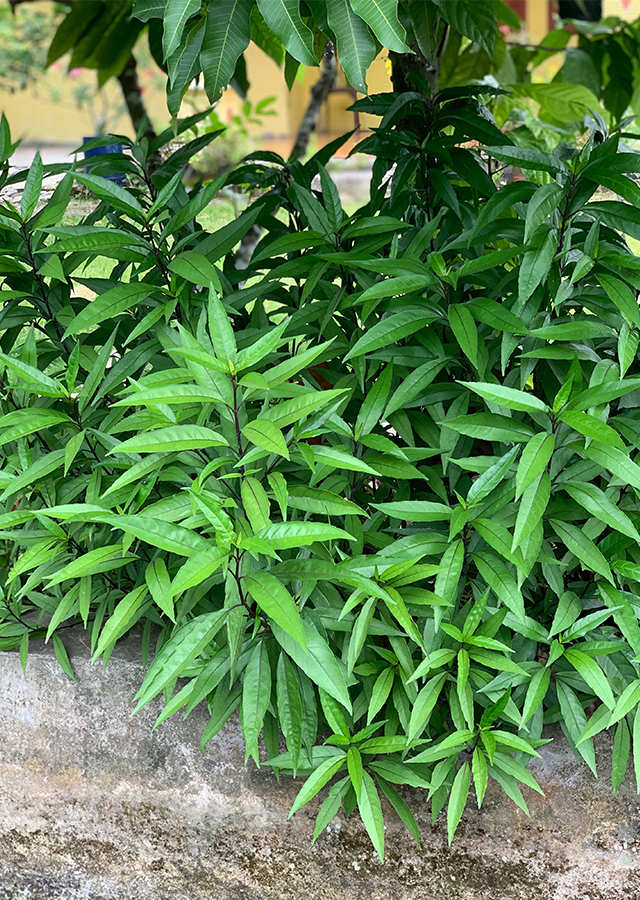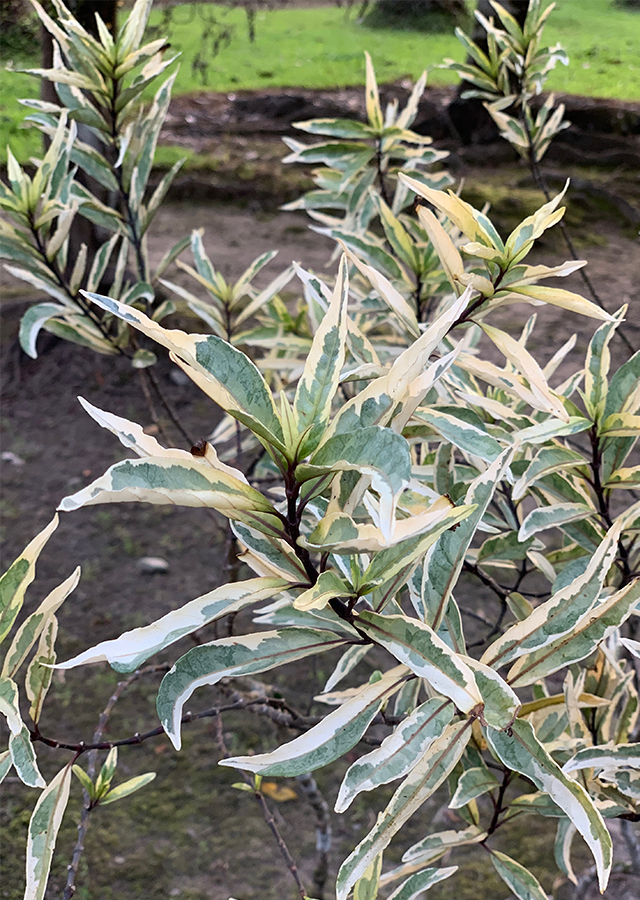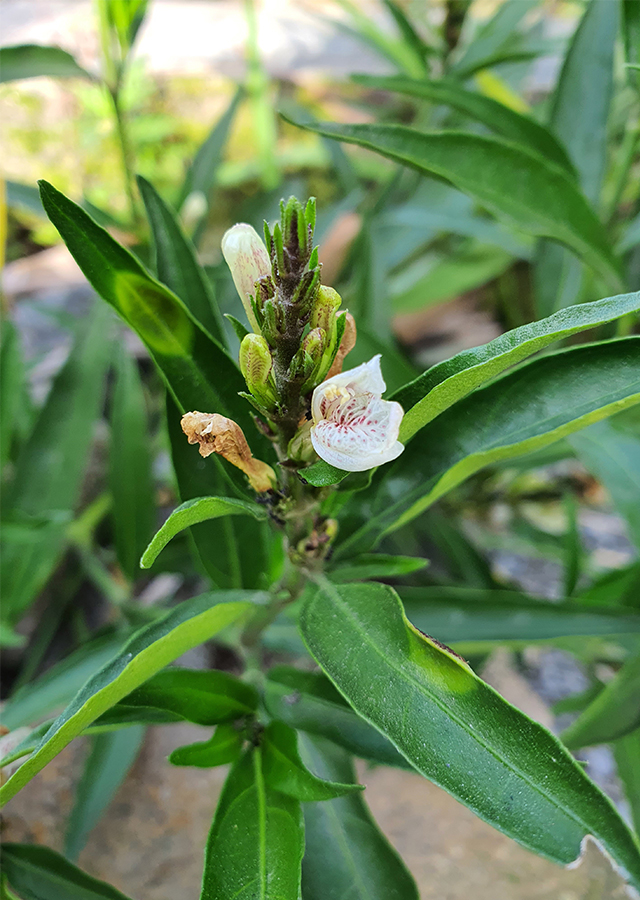Willow-Leaved Justicia
Justicia gendarussa Burm.f.
Acanthaceae
Location in our garden
Principal



Synonym
Adhatoda subserrata Nees
Dianthera subserrata Blanco
Dicliptera rheedei Kostel.
Habitus
Shrubs. A perennial, erect shrub, growing up to 70 – 150 cm tall.
Part Used
Leaves
Roots
Growing Requirements
Full Sunshine
Need Shade
Habitat
Riverbanks
Forest
Roadside
Shrublands
Overview
Willow-leaved Justicia is a native of the wet Himalayan lowlands of China. It is found all over South East Asia. The shrub is cultivated both as an ornamental plant and for its use in traditional medicine.
Vernacular Names
Temenggong (Malaysia), Kala adulasa (India), Bo gu dan (China), Natchouli (French), Justicia Kraut (German), Chiang phraa mon (Thailand).
Agroecology
In primary and secondary trees, roadsides and thickets, Willow-leaved Justicia grows along the sides of streams. It is ideal for soils that are light (sandy), medium (loamy) and hard (clay). It prefers acidic, neutral and basic (alkaline) soil and with a preference for moist soil, can grow in semi-shade (light woodland) or without shade.
Morphology
- Stem - at and above the nodes and internodes, multi-branched, smooth, terete and thickened
- Leaves - are In appearance, they are linearlanceolate and glabrous. They are lanceshaped, 1-2.5 cm wide, 7-14 cm long, and pointed at the ends.
- Flowers - are small, white with spots of pink or purple within. In 4-12 cm long spikes,at the end of the branches or in the leaf axils, the very tiny flowers are carried. Sepal cup teeth are smooth, linear, and approximately 3 mm long. About 1.5 cm long, white or pink with spots of purple.
- Fruit/Seeds - are capsule formed, club-shaped, about 1.2 cm long, and smooth, containing 4 seeds.
Cultivation
- Propagation by seed and stem cuttings.
Chemical Constituents
Justicin, alkaloids, saponins, flavonoids, flavonol-3-glikosida, essential oils, luteolin, iso orientin (luteolin-6-C-glikosida), coumarin, iridoid, triterpen, sterols, calsium oxalat, tannins.
Traditional Medicinal Uses
- Treat fractures, pain in the muscles, skin infections, sprains in the knees, diuretics, and internal parasites.
- It is used as an anti-cancer, antibacterial, hepatoprotective, anti-oxidant, antiangiogenic, anti-inflammatory and analgesic
- The treatment of chronic rheumatism uses a decoction of the leaves and young shoots.
- In the management of a wide variety of disorders, including head pain, paralysis of one side of the body and facial paralysis; lumbago, amenorrhoea, swelling, fever, cough, asthma, colic, eczema, cephalalgia, hemiplegia, facial paralysis, earache and hemicrania, the infusion of the leaves is taken internally.
- The leaves are also used in gonorrhoea, amenorrhoea and malaria treatment preparations.
- In the treatment of earache, leaf juice is applied topically.
- The fresh leaves are applied topically to alleviate headaches and pain as a remedy for oedema and swelling due to beri-beri and rheumatism. For bathing during and after childbirth, a decoction is used.
- The root is used as an antivenin and for the treatment of rheumatism, thrush, fever, cough, dysuria, diarrhoea and jaundice.
- To treat wounds, a decoction of the whole plant is used.
Part Used
Reference Sources
- Fern, Ken. (2019). Useful Tropical Plants, Justicia gendarussa, http://tropical.theferns.info/viewtropical.php?id=Justicia+gendarussa
- Flowers of India. (No date). Willow-leaved justicia, http://www.flowersofindia.net/catalog/slides/Willow-Leaf%20Justicia.html
- MINISTRY OF HEALTH REPUBLIC OF INDONESIA (2010). Guidelines for The Use of Herbal Medicines in Family Health Care. https://www.medbox.org/pdf/5e148832db60a2044c2d3947 07-04-2021
- National Center for Biotechnology Information, (2017). Botanical and Chemical Fingerprinting of Medicinal Roots of Justicia gendarussa Burm f., https://www.ncbi.nlm.nih.gov/pmc/articles/PMC5424564/
- Plants for a future (No date). Justicia gendarussa, https://pfaf.org/user/Plant.aspx?LatinName=Justicia+gendarussa
- ResearchGate. (2014). Phytochemical and Pharmacological Profile of Justicia gendarussa Burm f. – Review , https://www.researchgate.net/publication/280385739_Phytochemical_and_Pharmacological_Profile_of_Justicia_gendarussa_Burm_f_-_Review

